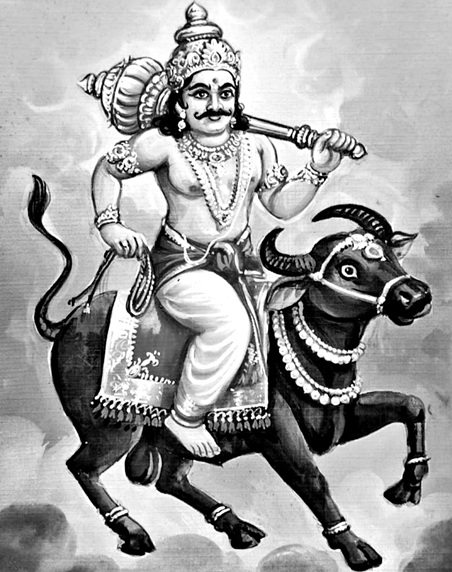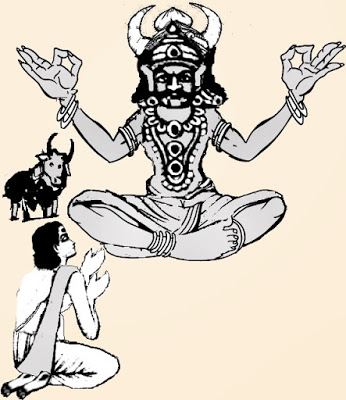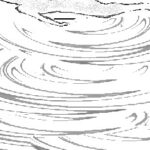Yama Dharmaraj
Santhipriya

Yama Dharmaraja is considered to be the God of justice or God of death. He is dark complexioned and have fearsome look. Although he was not worshiped in any of the temples during the era of Veda, he was worshiped for the welfare of the souls of those who died. However few temples of Lord Yama have come up in later centuries. As per few puranic stories, Lord Yama was appointed as custodian of those who died as he was the first to die after creation of the universe. While some laugh away this as unbelievable story, the pundits interpret the story of his death as transfiguration of serene heavenly body into that of a fearsome one before the humans were created and given life.
According to mythology, initially when the universe was created, Lord Yama was not created and thus the first of the three yugas functioned without Lord Yama. Since there was no death after the Yugas were created, the earth began to sink under the ocean due to ever increasing weight of creations and therefore unable to bear the weight, Goddess earth (Bhoomadevi) sought the intervention of Lord Vishnu to relieve her suffering. Immediately Lord Vishnu manifested in the form of Lord Varaha and lifted the earth sunk in the ocean and saved her. Therefore the need of creating some one to cause death and to take the custody of the dead soul was felt and Lord Yama was created. The second Yuga when Lord Yama was absent was when Lord Shiva caused the death of Lord Yama in order to save his devotee Markandeya. Subsequently Lord Yama was again given birth by the same Lord.
When Lord Yama was first created, his appearance was serene, but Lord Shiva wanted him to transform his appearance to that of cruel and terrifying one which was one of the rules of divine principles of creation. Once Lord Yama transformed himself into that of terrible form, he would be made the custodian of the southern part of devaloga, where the dead souls would be sent and Lord Yama would mete out due punishments to them to the extent of sins each of the souls had committed, and at the end of the period of punishment, the souls would be sent back by him for taking rebirth as destined when they were created in the universe. Every soul were destined with birth and death for certain prescribed period and they would get punishments and rebirth commensurate to the sins they would commit after taking birth in any form.
There is misconception on the role of Lord Yama, most of which are untrue. He has been created to uphold the law of divine and to impartially execute the punishments, which he does to the sinner souls in Yama Log. It is stated in the Brahmanical texts that since the abode of Lord Yama is in the southern side in the directions, the journey in that direction would take one to ultimately reach Yama log, the abode of Lord Yama.
Lord Yama’s birth is not without controversies. According to few legends, he was the son of Lord Surya (Sun) and brother of Lord Saneeswara. According to the text of Mahabharata, he married ten daughters of King Daksha and as per the scripture of Rig Veda, no worship for Lord Yama was in vague during the Vedic period and his worship began much later. People offered worship to Lord Yama during the rites performed for the dead in their family and Lord Yama was prayed requesting him to keep the souls rest in peace without thirst and hunger. One of the Deva ganas is Chitragupta who assists Lord Yama to perform his acts. The carrier vehicle of Lord Yama- bullock- is called as Pooraka, the male bullock which emanated from the thigh of Lord Rudra, the incarnation of Lord Shiva.
Lord Yama has been portrayed as the spiritual master (Guru) in Kathopanishad, which is one of the important Upanishads while rest of the Puranas referred Lord Yama as the punisher of sinner souls. Except Garuda Purana which often mentions Lord Yama in its text, other Puranas have only given passive references on Lord Yama. The Kathopanishad consists of 120 slokas or verses and it is one of the most popular Upanishads for its simplicity in unraveling the highest truth of Atman (soul)- ‘What is death and what is after death’ – easily comprehensible to everyone. One of a young Brahmin boy named Nachiketa who on observing the sacrificial ritual performed by his father, in which old and disabled cows were given away as gifts to the invitees, insisted his father to offer him (Nachiketa) as gift instead of the cows to gain fruits of the ritual. He further insisted his father to tell him as to whom he would donate him. Nachikeda’s father unable to control his anger, in an act of desperation replied that he could only gift him (Nachiketa) to Death (i.e. Lord Yama).
Unable to unravel the truth on death, Nachikeda’s father with his yogic power sent him to Lord Yama to get his doubts cleared. Since Nachiketa was highly learned, he requested Lord Yama to enlighten him on some of the unlearned issues surrounding life and death and debated with him for three days. Prior to the three days session, Nachiketa sought for three wishes which Lord Yama agreed to grant because observing the determination, faith, sincerity, and perseverance of Nachiketa who even resisted the temptations of several offers from Lord Yama for health, life, riches, jewels, enjoyment, lasting kingdom, anything in the world or of heaven, but remained firm in his desire to know the secrets of life and death. Lord Yama realized that Nachiketa was perfect disciple and therefore agreed to clarify about the ultimate reality which is Brahman or Atman and cleared all his doubts as if he (Lord Yama) was the spiritual master to the boy as claimed in Kathopanishad.
While in discussion Nachikeda asked ‘My doubt be cleared Lord Yama, consequent on the death of a man some say the ‘It’ exists, while others referring the soul say ‘It’ does not exist’. I would like to know, master, what is the truth on ‘It’?’ Lord Yama sat with him for three days and clarified all his doubts to ultimately state that: ‘Realize my son, ‘It’ is the Atman (Soul) which is the one without beginning or end, formless, ever eternal, soundless, intangible, tasteless and odorless and remained beyond everything, then ‘It’ is freed from the jaws of death. The goal which all the Vedas declare, which all austerities aim at, and which everyone desire to achieve is nothing but Aum (State of ‘Aham Brahman’ which means I am the infinite reality’). Thus Lord Yama remained as Gnana Guru who clarified through his true disciple ones ’doubt on life after death and death after life.
Yet another story on Lord Yama is available through a folklore. It portrays the impartiality of Lord Yama while awarding sentences to sinners. Once a washer man was sent to Yamaloga after his demise and when his soul reached there it found the golden chair of Lord Yama empty as Lord Yama had gone out. Elated washer man’s soul sat on the chair and slept. It dreamt as though someone was stealing money from his shirt. Angered with the thief, he got up and threw the golden chair over the thief which broke and later realized that it was a dream. In the meanwhile Lord Yama too returned back. Finding his golden chair lying broken in a corner, he inquired the washer man’s soul and learnt of the reason. However Lord Yama recalled the past acts of the soul as washer man when he himself clandestinely stole valuables from the clothes of others. Lord Yama who did not lose his cool asked how many chairs would have been thrown on him while engaged in such a cowardly act. Though Lord Yama listed out such instances, he ultimately sent the washer man’s soul to heaven since the washerman’s sin vanished on account of sitting in the seat of Lord Yama which was a sinfree chair The act of Lord Yama reveals that Lord Yama was not all that cruel in nature as was projected or feared, but his manifestation is such that he had to act in fulfillment of his obligation to the Supreme and to carry out the law of divine like a committed soldier in his armor of creation and destruction.
Sometime after the Universe was created, frustrated that he was not respected by mankind but viewed with contempt and offered worship only out of fear and not with respect, Lord Yama in immense mental agony and tiredness decided to retire from his duty and seek salvation by penance. He left Yama log after handing over his charge to his deputy Chitragupta to handle the sinners and punish them strictly according to rule book and searched for a place to sit in penance. He travelled to more than 150 places and sat in penance, but he could not complete the penance without disturbance which came in some way or the other, nor was Supreme Lord Shiva appearing before him to grant the boon he desired. On the 151th place, an unknown voice came from heaven telling ‘Lord Yama, there is no use wandering here and there to achieve your cause. Go to Sri Vanchiyam (the name Sri Vanchiyam did not exist at that time and therefore he was told of the specific place where Sri Vanchiyam existed) and stay in penance. Supreme Lord will appear before you to grant the boon you desire’.
On hearing the unknown voice which came from heaven, Lord Yama immediately proceeded to Sri Vanchiyam and sat in penance. Many years passed, and pleased with the arduous penance of Lord Yama, supreme Lord Shiva appeared before him seeking to know of his wish. Lord Yama pleaded ‘My Lord, I am completely shattered, commanding no respect on earth who outwardly offer obedience to me only out of fear and not with respect as I am viewed cruel in nature and punisher, while all other Gods are respected and worshiped with reverence in heart by the humans. Nowhere in any of the temples on earth I am glorified, or have separate sanctum to sit, nor am I worshiped. Lord Ganesha receives the first prayer indirectly implying unless Ganesha is first prayed other Gods shall not grant boons. But my Lord, my pity be seen. Though a faithful soldier of thine, even in your temples I have no place to sit with respect. I am unable to absorb the curses from the sinners who are punished in my abode. The continuous hearing of their screams and curse cause mental agony and truly I have become tired beyond belief. Further I have been humiliated when Markandeya at the destined time of his death clung on to you and saved himself by your grace thus making mockery of my authority. Therefore Supreme Lord, be kind enough to grant me salvation and relieve me of my duties’.
Moved by the prayer of Lord Yama Supreme Lord Shiva granted him a boon that in a temple to be enshrined for him (Shiva) in Sri Vanchiyam in some time to come then, those visiting there would first offer oblation and worship to Lord Yama who shall have separate shrine inside. Unless Lord Yama was worshiped Lord Shiva’s grace shall not be received by them. At the same time Lord Yama shall remove the fear of death from the minds and hearts of devotees, and bless them for longevity and to live in peace.
While Lord Yama shall not get physical salvation to reach heaven, but attain salvation in mind and heart. None of the curses of those dead shall have any effect on him. Though Lord Yama requested the Supreme Lord Shiva to accept him as his carrier instead of Nandi (Buffalo), the plea could not be accepted, however since Lord Shiva manifested before him in the month of Masi (mid-February to mid-March) in Bharani Nakshatra, every year in a ceremony to be held for Lord Shiva in the month of Masi, Lord Yama shall remain the carrier for Shiva and Parvathi instead of Nandi the permanent carrier of Lord Shiva. On the said day, Nandi shall take rest in front of Lord Yama’s sanctum there. Therefore Sri Vanchiyam has become the only temple in the world where Lord Yama has been given the status of prime deity who shall be offered oblation and prayers first before seeking boon from Lord Shiva.
As per the legend the temple (place of worship without building) dates back to the Treta Yuga and has been built as temple with the existing structure during Chola (one amongst the three dynasties namely Chera, Chola and Pandya) period. In his sanctum, Lord Yama is seen accompanied by Chitragupta with Nandi taking rest in front of his sanctum. The presiding deity of the temple is Lord Shiva in the name of Lord Vanchinathar and the name of the Goddess is Mangalambika. The sacred tree of this temple (Sthala vraksha) is Sandalwood tree. Sri Vanchinatha Swami Temple is located 15 km north of Thiruvarur off Kumbakonam-Nannilam Highway (Tamil Nadu in India) between Mudikondan and Puthoor rivers. Those who die in this village are considered to be free from the sufferings preceding their death.
There are some more temples dedicated to Lord Yama in India. One Lord Yamaraj Temple is in Tiruchitrambalam near Pudukottai. There is another temple for him in Parmur in Samba district of Himachal Pradesh at an altitude of 7000 feet near Dharmehwar Mahadev temple. It is stated that this temple is over 1400 year’s old.
As per a temple history in a place called Tirukadaiyur, Lord Shiva done to death Lord Yama to save his devotee called Markandeya, and from then on there was no death on earth and overburdened with the weight of the humans, Booma Devi (Goddess of earth) prayed with Supreme Lord Shiva to relieve of her burden by bringing back to life Lord Yama. Pleased with her prayer, Lord Shiva again brought back the life of Lord Yama, but from the stage of a child. Once born Lord Yama grew fast and took up his past responsibilities thus relieving Booma Devi (Goddess of earth) of her burden. In the outer precincts of the temple Lord Yama can be seen lying at the feet of Lord Shiva and Goddess Parvathi.
Apart from Sri Vanchiam in Tamilnadu, one more temple for Lord Yama has been built for him in a place called Vellalore near Coimbatore in India. The temple is about 20 KM from Coimbatore in the main line leading to Guruvayur and Trichur. The temple is reportedly built three hundred years ago by the first of the seventh generations of temple priest Palaniswamy. Prior to the construction of the temple Vellalore faced the danger of getting wiped due to flood from a nearby river. Lord Yama, who appeared in the dream of a local, stopped the catastrophe and asked him to build a temple for him there.
Happy with Lord Yama who saved the land when the local in whose dream Lord Yama appeared, searched for a suitable land to build the temple. He found a land similar to the one he saw in his dream and tried to contact the owner who was a Brahmin. Surprisingly when he reached the spot met the owner of the land who was standing there and narrated his dream, and requested him to part with the land for a suitable price, but surprisingly the owner of the land not only parted with the land but also told him to take as much as land required for the construction of the temple. He did not take any money for the land sold. Rest of the work started fast and a temple for Lord Yama, which could be reached by walk through a narrow footpath in the midst of a sugarcane sapling, came up in a very short time. In the sanctum fearsome looking Lord Yama could be seen seated on a black buffalo facing south holding weapon Ankus in one of his hands. While women are not allowed to go beyond the sanctum of Vinayagar (reason not known) men can go near Lord Yama to perform puja and worship him.






Hearing the name of Yamraj, the souls of many people tremble. In such a situation, if you see Yamraj, then you will be really scared. But according to the dream scripture, seeing Yamraj in a dream gives auspicious signs. According to the dream scripture, if Yamraj comes in someone’s dream, then it is a sign of freedom from diseases.